Books
Susan Hill on Margery Allingham
by Susan Hill
‘The ancient smell of evil, acrid and potent as the stench of fever, came creeping through the gentle house to him, defiling as it passed.’
That sentence sets the tone of this masterpiece, Margery Allingham’s finest book and one of the greatest crime thrillers ever written. The Tiger in the Smoke is not a plot-driven, easy-read detective story, as enjoyable as a cup of tea in an armchair by the fire, and slipping down just as pleasantly. It is very different, and far more serious. It does have a detective – Allingham’s Albert Campion, plus an array of policemen from London’s CID, and it does have quite a convoluted plot. But those are almost asides to this dark and often frightening book. At its heart is indeed ‘the ancient smell of evil’ in the shape of ruthless murderer, Jack Havoc, and of the albino pack-leader Tiddy Doll. There are brutal, even gratuitous murders, by hideous knifing and beating, and we learn fairly quickly who committed them. But this is not a whodunit, it is a why-dunnit, a complex novel of character. It is also, at its core, about the essential Biblical, and specifically, the Miltonian, conflict between good and evil: the devil in the shape of Jack Havoc, and an angel, the saintly Canon Avril.
There are not many crime novels more genuinely frightening and fewer that can be read and re-read without boredom. Pick up most detective novels by Golden Age writers – Allingham was one of the best of those – wondering if you have read it before, and within a few pages, if you discover that you have, you will cast it aside. You know who did it, why and how, and you could not be less interested in finding out all over again. One of the marks of a good novel of any kind, is that it yields more with each re-reading. The workings of the plot of The Tiger in the Smoke, once known are known for good and another reading simply kick-starts the memory. It is everything else that bears the weight of several readings.
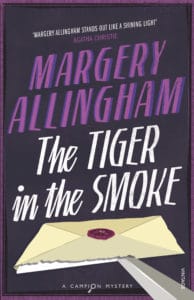 Margery Allingham, like Dickens, was a London-lover, and kept a flat there even when she lived mainly in an Essex village. Like Dickens, and many writers before and after her, she enjoyed simply walking about the city, looking, listening, taking in. She sat in tea-shops or on benches or in churchyards, and people gravitated to her and then they talked. She undoubtedly lent a sympathetic ear but the writer in her was working away all the time, storing phrases, conversations, details. Secrets. London worked its way into the heart of many of her books, and especially into The Tiger in the Smoke. It became a character, just as it is in Dickens’s Bleak House or Our Mutual Friend or Little Dorrit. Its ways and weathers, its courts and alleyways and squares and hidden side-streets, affected those who lived and worked among them, and helped to form them. Even the policemen in this thriller have their patch of London woven through them and the view they take of life and crime. They know it back to front, as Allingham did. Only then could she weave and enmesh her book and its characters with the city in the confident way she does.
Margery Allingham, like Dickens, was a London-lover, and kept a flat there even when she lived mainly in an Essex village. Like Dickens, and many writers before and after her, she enjoyed simply walking about the city, looking, listening, taking in. She sat in tea-shops or on benches or in churchyards, and people gravitated to her and then they talked. She undoubtedly lent a sympathetic ear but the writer in her was working away all the time, storing phrases, conversations, details. Secrets. London worked its way into the heart of many of her books, and especially into The Tiger in the Smoke. It became a character, just as it is in Dickens’s Bleak House or Our Mutual Friend or Little Dorrit. Its ways and weathers, its courts and alleyways and squares and hidden side-streets, affected those who lived and worked among them, and helped to form them. Even the policemen in this thriller have their patch of London woven through them and the view they take of life and crime. They know it back to front, as Allingham did. Only then could she weave and enmesh her book and its characters with the city in the confident way she does.
The London of Tiger is the London of light and dark in many senses – the good and evil men and women, their souls and their deeds, are mirrored by the two faces of the city. Canon Avril’s vicarage is warm, comfortable and comforting, an oasis of muddled and challenged but essentially happy extended family life, as well as the place where church mingles with domesticity and is the homely background to the vicar’s own, slightly eccentric brand of holiness and spirituality. And then there is the other London, where a rag-tag street band of ex-soldiers and vagrants live in a bleak cellar when they are not wandering the streets playing a cacophony of instruments and where they go in fear of their leader, the albino Tiddy Doll. There are the dark sidealleys where a man can be trapped and 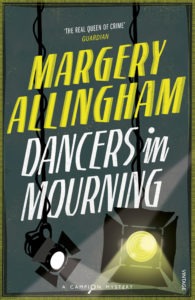 murdered, the soul-less public houses where people meet swiftly and secretly, and the great railway stations, filled with the noise and steam of trains and passengers spilling from them, where a small-time criminal is masquerading as a dead army officer for purposes which are unclear – not least to him. Overall, there is the fog, a Dickensian ‘London Particular’, spreading like a stain, insinuating itself into every crack and crevice, muffling and blinding and confusing, making the work of the police hunting a murderer twice as hard. The fog is sinister and frightening. And anything may happen in it and be concealed, secrets, evil deeds, swift, cunning movements. The fog gets into nostrils and lungs and eyes – and in some strange way, into hearts and minds, too. It is more, far more, than merely a tiresome feature of winter weather in the great city.
murdered, the soul-less public houses where people meet swiftly and secretly, and the great railway stations, filled with the noise and steam of trains and passengers spilling from them, where a small-time criminal is masquerading as a dead army officer for purposes which are unclear – not least to him. Overall, there is the fog, a Dickensian ‘London Particular’, spreading like a stain, insinuating itself into every crack and crevice, muffling and blinding and confusing, making the work of the police hunting a murderer twice as hard. The fog is sinister and frightening. And anything may happen in it and be concealed, secrets, evil deeds, swift, cunning movements. The fog gets into nostrils and lungs and eyes – and in some strange way, into hearts and minds, too. It is more, far more, than merely a tiresome feature of winter weather in the great city.
In real life, criminals are rarely very interesting and certainly, unless they are of the charming-psychopath type, rarely intriguing or attractive – but detective fiction usually benefits from having a murderer who exerts a terrible fascination, and in no book of Margery Allingham’s is it more true than this one. The setting is so powerful, and many of the subsidiary characters so idiosyncratic and interesting, that the central character of the villain has to make a very strong impact. Jack Havoc stands up to everything. He is her most repellent, dangerous, evil, and unusual killer, a man with a wounding childhood, and a strange past history, without emotion or empathy or conscience, and yet not entirely without humanity, cold-blooded, shocking, brutal, and yet perhaps, just perhaps, redeemable. Canon Avril believes so, as he believes is true of every human being, and in the magnificent scene in which he finally comes face to face with Havoc in the dark church, the battle between the two men, the great Miltonic battle, all but proves him right. But if Havoc is an outstanding creation, the street band – almost a single character – is Allingham’s stroke of genius. At a first reading, we may fail to notice them as they are slipped in here and there, heard from a distance, or from somewhere inside, as they march past with their hideous noise, which could never be dignified with the name of music, and the clatter of 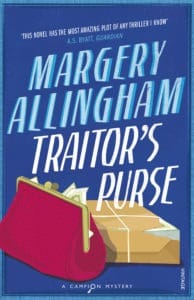 their collecting tins. They are part of the London street scene and din. They go past the pub in the fog, close to the alley in which Havoc’s first victim lies dead, and turn up among the stalls and shoppers of the foggy little street market, on their way to the cellar they call home. Gradually, it dawns on us that this is no bit of local colour, and the moment we come close to the band, and especially to the poor doomed dwarf, and to hang-leader, we receive the full, shocking implication of their presence and purpose. Tiddy Doll, the albino leader, is a grotesque villain worthy of a James Bond novel, with cunning but no intelligence, and a sadistic anticipation of any potential for violence, especially if it takes the form of torture. Jack Havoc is a ruthless and efficient murderer, who uses his knife swiftly and expertly, to kill. He is not especially stimulated by inflicting pain for its own sake and perhaps, for that reason only, he is a better man than his inferior and minion, Tiddy.
their collecting tins. They are part of the London street scene and din. They go past the pub in the fog, close to the alley in which Havoc’s first victim lies dead, and turn up among the stalls and shoppers of the foggy little street market, on their way to the cellar they call home. Gradually, it dawns on us that this is no bit of local colour, and the moment we come close to the band, and especially to the poor doomed dwarf, and to hang-leader, we receive the full, shocking implication of their presence and purpose. Tiddy Doll, the albino leader, is a grotesque villain worthy of a James Bond novel, with cunning but no intelligence, and a sadistic anticipation of any potential for violence, especially if it takes the form of torture. Jack Havoc is a ruthless and efficient murderer, who uses his knife swiftly and expertly, to kill. He is not especially stimulated by inflicting pain for its own sake and perhaps, for that reason only, he is a better man than his inferior and minion, Tiddy.
In many ‘Golden Age’ detective novels of the 1920s to 1940s, the police are either peripheral, or mere bumblers, saved by the keen brains of an amateur sleuth. Margery Allingham did not buy into that myth but in the first novels featuring Albert Campion, her private detective bore many of the hallmarks of the upper-class twerp who somehow manages to solve crimes the professional cannot fathom. He had something of Bertie Wooster about him, and a lot of Dorothy L. Sayers’s Lord Peter Wimsey. Campion had a bland face with a goofy expression, wore glasses, spoke in a cut glass accent and had no chin. He managed to look either absent or foolish, while his brain was working overtime to outwit both criminals and police.
But the Campion of Tiger has changed into an altogether more serious, thoughtful man. He has the responsibilities of a wife and young son, he is taken seriously by the CID, and helps them not only by use of brain but of brawn – he races about London in an effort to stop Havoc committing yet another murder, he takes a full and active part in an attempted sting at Paddington station, and he is early on the scene when the hiding-place of the street band is discovered and raided. This is a man of courage and determination. He uses a well-trained and clever mind, but he collaborates fully, never going out on a limb against their advice, or making them look incompetent fools while he solves an abstruse 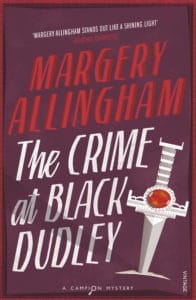 puzzle. He is not near enough when his wife, Amanda, almost comes face to face with Jack Havoc, and Campion immediately sends her and their son, Rupert, to the country, on a drive through the fog accompanied by the stalwart Magersfontein Lugg, his old amanuensis. He knows that Havoc is an evil man. He can smell it. He is not foolhardy, only determined, and he understands the risks they all run in their bid to catch the murderer.
puzzle. He is not near enough when his wife, Amanda, almost comes face to face with Jack Havoc, and Campion immediately sends her and their son, Rupert, to the country, on a drive through the fog accompanied by the stalwart Magersfontein Lugg, his old amanuensis. He knows that Havoc is an evil man. He can smell it. He is not foolhardy, only determined, and he understands the risks they all run in their bid to catch the murderer.
In short, we can believe in Campion, we can respect and like him, and he does not irritate us, as he once did, and as Lord Peter Wimsey never really fails to do, for all his charm.
The plot of The Tiger in the Smoke is too convoluted to make for easy summing-up, but that scarcely matters, because although it is exciting enough, it is the least of the book, a peg on which to hang a study of evil and of good and to provide an excuse for some marvellous set-pieces. The moment when Jack Havoc coolly opens a small high window and drops down from street level into the cellar, watched in all stages of horror and surprise by the street musicians below, is breathtaking. The description of the empty house through which he creeps at night, looking for a vital piece of paper, while Amanda and her companion hold their breath in terror a few feet away, makes the reader’s heart race. But why a man is pretending to be the dead soldier husband of a beautiful young woman, why her fiancé is in the pub close to and minutes before a 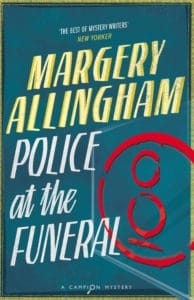 small-time villain is murdered by Havoc, and what hidden treasure in a remote house on the French coast has to do with it all are at once crucial and irrelevant. If there are one or two plot-inconsistencies, it scarcely matters.
small-time villain is murdered by Havoc, and what hidden treasure in a remote house on the French coast has to do with it all are at once crucial and irrelevant. If there are one or two plot-inconsistencies, it scarcely matters.
Are there any flaws in this superb thriller? At the beginning, when we are introduced to the young and beautiful war-widow, it feels dated – the women are over-dressed, pearl-wearing cigarette smokers who, in their early twenties, might well be fifty, and some of the cut-glass dialogue, before the shadow of Jack Havoc and the sinister aura surrounding the street band, darken the scene, seems very stilted. The Second World War is still very close to London and its citizens – the novel was written in the early 1950s – its physical aftermath still visible, its sufferings raw. To the 21st century reader, that is all much farther away.
Otherwise, I know of only half a dozen classic crime thrillers which come near the quality of Tiger, and few of their authors who write anywhere near as well as Allingham at the top of her game. It survives because it is a very fine book indeed, it survives for many of the same reasons that Dickens survives. And how many crime writers can stand serious comparison with that magnificent genius?
1 Comment
Join the discussion
Please note: Moderation is enabled and may delay your comment being posted. There is no need to resubmit your comment. By posting a comment you are agreeing to the website Terms of Use.

Which half-dozen thrillers would you recommend which approach the quality of this one?